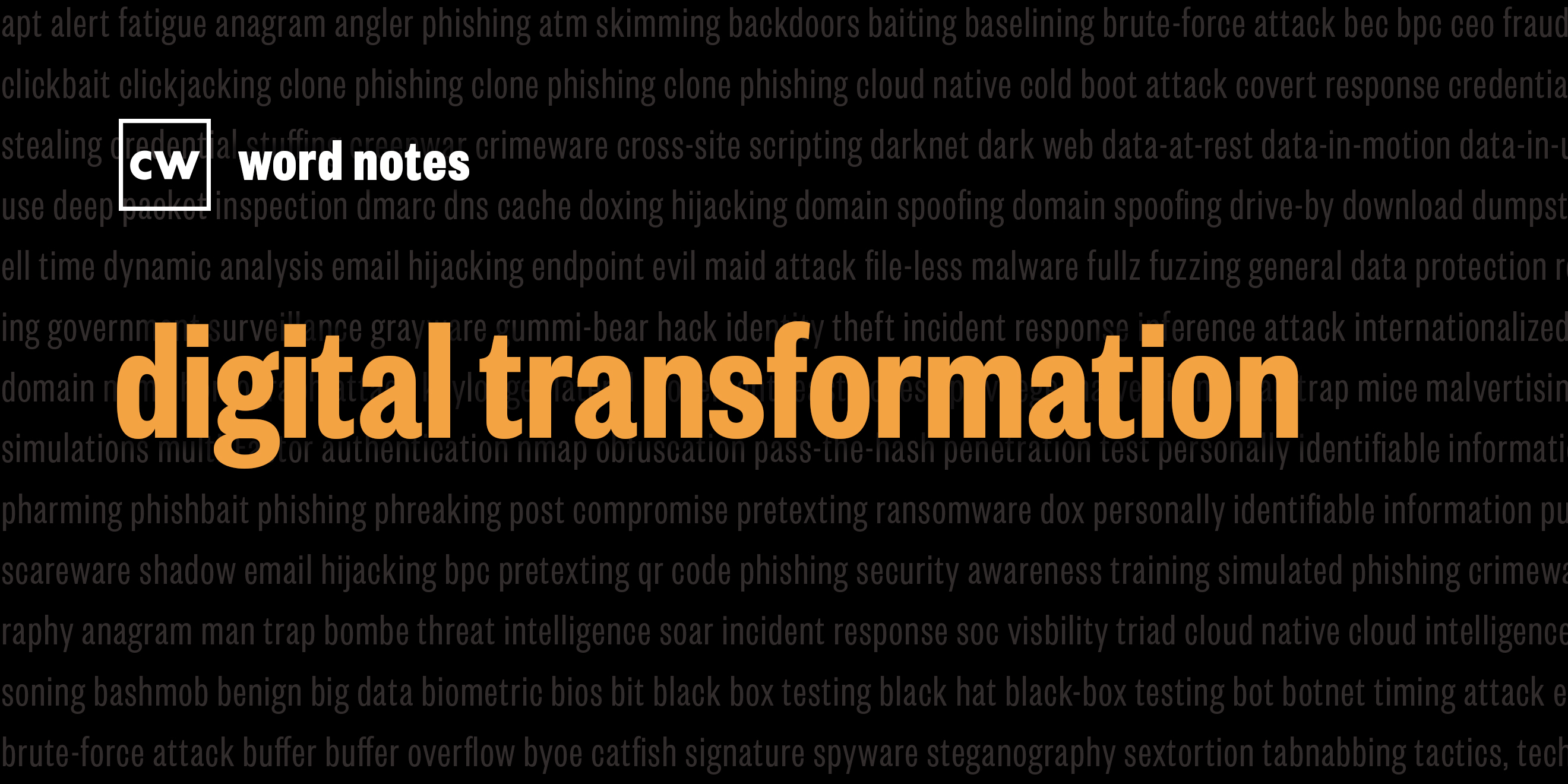
digital transformation (noun)
Rick Howard: The word is: digital transformation.
Rick Howard: Spelled: digital as in available in electronic form and readable and controlled by a computer, and transformation as in a change in form appearance, nature, or character.
Rick Howard: Definition: The use of technology to radically improve the performance or reach of the business.
Rick Howard: Example sentence: The pressure to cut expenses, minimize risk, and keep up with the demands of evolving customers, requires companies to adopt a holistic approach to leveraging digital transformation.
Rick Howard: Origin and context: According to Daniel Schallmo, Christopher Williams, and Luke Boardman in their paper, "Digital Transformation of Business Models," they highlight that back in the '90s, even though purchases were still primarily made inside brick and mortar stores, often with cash mass media advertising started tapping into smart devices and social media platforms as methods customers used to communicate with businesses. Businesses started to see that they were now able to communicate digitally with their customers on an individual basis and often in real time. By August, 2004, when Larry Page and Sergey Brin took Google public, they also made an internal game-changing decision about how to manage their growing digital infrastructure.
Rick Howard: Instead of handing the task off to the traditional network management and IT management teams, they gave the task to the development team and essentially invented the idea of infrastructure as code six years before we had a name for it. By 2010, some startups realized that they could gain a competitive edge by deploying their products through this model. They would combine the development and operational functions into one DevOps process using code as the glue.
Rick Howard: By doing this, they became more agile in their ability to respond to customer needs compared to their larger competitors who still kept development and operations separate. These old brick and mortar companies might take two years to deploy new functionality to their website. The digitally transformed startups were bragging about 10 new deployments a day.
Rick Howard: Nerd reference: Back in 2009, two Flicker employees, John Allspaw, senior vice president of technical operations, and Paul Hammond, director of engineering, gave a now famous presentation at the Velocity 2009 conference titled,10+ Deploys per Day: Dev and Ops Cooperation at Flickr" leading to the concept of a new role combining developers and operations, in other words, DevOps.
John Allspaw and Paul Hammond: From a development point of view. One of the most important things you can do is to set up one step. And what we mean by that is, everything you need to do to take the code that is currently in your source control system in SVN. And turn that into a set of files that can be copied onto a production server and run the site. The screenshot that I'm showing on the screen right now is a part of Flickr's internal development, admin interface. This is the build and stage button, the button at the very bottom of the screen, the one that says perform staging, you click that button, it performs an SVN checkout. It does all of the translations that compiles all the templates, anywhere where we have, completion that we do for optimization. It does all of that. And then it copies that code onto a staging service that we can do. Automatically automatically, which means that, you don't have people running this command and then you run this command. As it turns out, computers are really good at running commands the same time and the same order over and over again. Once you've got that one step build. The next thing you need is a one-step deploy. This is Flickr's internal admin tool for deploying. We have a button that says I'm feeling lucky and you push that and it pushes the code out to the site. The same principles apply here by making it one button. It means that there's very, very little room for error. It means that you're doing your builds and you're doing your deploys in a consistent environment. It means that there's no manual steps that might go wrong. This is the way we do things. But you see this as a trend, continuous deployment and continuous integration is starting to show up in a lot of operational tools and even vendors selling things and open source projects as well. So it's just a good idea.
Rick Howard: Word Notes is written by Nyla Gennaoui. Executive produced by Peter Kilpe, and edited by John Petrik and me, Rick Howard. The mix, sound design, and original music have all been crafted by the ridiculously talented Elliott Peltzman.
Rick Howard: And thanks for listening.

